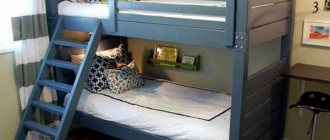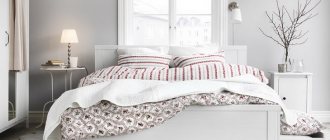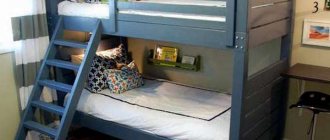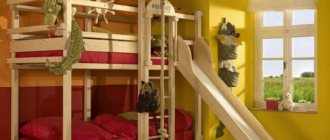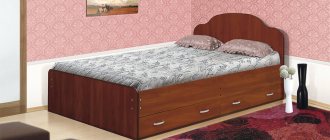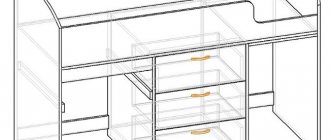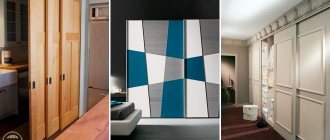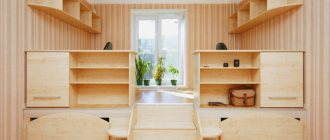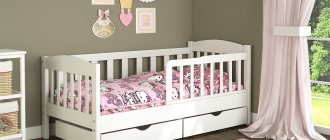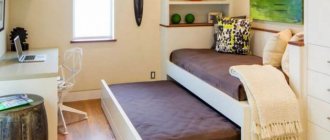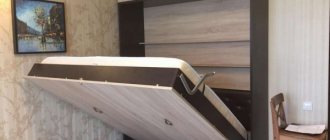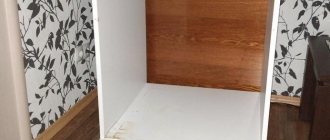SHARE ON SOCIAL NETWORKS
FacebookTwitterOkGoogle+PinterestVk
The main area in the children's room is occupied by beds. As children grow older, there is a shortage of free space in the room. A DIY bunk bed will help solve this problem. There are many design models that are selected based on the age of the children, the size of the room and personal preferences. You can learn more about the types of bunk beds and options for making them yourself in this article.
A bunk bed will help solve the problem of lack of free space in the room.
Optimal dimensions of a bunk bed
When designing a bunk bed made of wood or metal, special attention should be paid to the strength and stability of the structure. Here it is necessary not only to create comfortable sleeping places, but also to properly organize the stairs to climb to the second floor. At the initial design stage, you need to think about where the staircase will be located. Next, the sleeping places are calculated and the distance between the tiers is calculated. These values are determined in such a way as to guarantee convenient operation of the structure in the future.
For the safety of the child, the upper tier should not be placed too high
The distance from the lower tier to the floor level is selected based on a calculation that allows for comfortable seating for an adult. The niche that will be formed under the lower tier can be filled with drawers for linen or other things. The height distance between the beds should allow an adult to sit comfortably. This requirement is met not only for the convenience of the parents, but also for the safety of the child sleeping on the lower tier, who should not hit his head on the upper bed when jumping up.
The top tier should not be placed too high. This will be dangerous for a sleeping child. He will also feel uncomfortable because the room above will be too warm for him to feel very stuffy.
The optimal dimensions of a sleeping place are considered to be the following: 160x70 cm and 180x80 cm. The recommended height of the structure is 160-180 cm. The height of the sides of the second tier should be at least 35 cm, which depends on the thickness of the mattress. The most acceptable dimensions for a staircase are width 39 cm, height 150 cm, distance between steps 25 cm.
It is recommended to make the sides of the bed at least 35 centimeters high
Constructions
There are many varieties of children's bunk beds. And it's not about the size, but about the designs. Let's start with the principles of construction:
- The basis of the structure is a frame made of timber, to which all other parts are attached: sides, railings. The bars must be higher than the level of the upper lounger by the height of the back or sides. To ensure safety, the height should be at least 40 cm from the top edge of the mattress.
The design is based on four vertical beams, to which all other parts are already attached.
- They make two identical beds with thick posts and a strong frame. One is placed on top of the other and connected using dowels or pins. If the height of the legs and backrest is not enough, and the mattress of the upper tier is too low, the racks are further increased, not forgetting to strengthen the joints.
- A workplace is arranged below, and a sleeping place above. Such 2-tier beds are also called “loft”. This option is for those whose children compete with each other. And two sleeping places on different floors will cause constant conflicts. Two such “kits” solve the problem. Read about the types of attic beds and how to make them yourself.
A two-story loft bed is a great solution for a small space or competitive children.
- Corner arrangement of beds. When the bedrooms are not located one above the other, but against two adjacent walls. Then below there is also the opportunity to organize a workplace or play space ().
- The sleeping places are located along one wall, but not above each other, but shifted. This option makes it possible to use the available space more efficiently - fill it from wall to wall.
- Roll-out or pull-out two-story children's beds. This is a transformable furniture option. During the day, the lower berth is hidden under the upper one. With this construction, the height of the bed may be small. This is a solution for those who are afraid that children may fall from the second floor or stairs.
The choice of designs is great, but that's not all. Stairs add further variety. They can be ordinary, like on a wall bars, or in the form of steps or boxes stacked on top of each other. The most economical option is conventional: they require little material and take up little space. But you can put things in a ladder of drawers, like in a chest of drawers, which is also practical. And such steps are even more reliable: you can attach high railings to them to make them even safer.
Stairs made of rungs or steps can be located in front - along the long side of the beds. At the same time, they are sometimes made in the center, sometimes on the right or left. Another option is stairs from the end. They are also made vertical, and then they take up almost no space, and sometimes at an angle. It’s easier to climb on these, but it’s not always possible to place them: the space doesn’t allow it, and it’s easy to get caught on the protruding legs.
Types of bunk beds: photos of interesting options
The option of a 2-story bed is selected depending on the purpose, age of the children and their personal preferences. A younger child usually sleeps on the bottom bunk, while his older brother or sister occupies the top bunk. The two-tier design can also be used for one child. In this case, the sleeping area is located at the top. Underneath there is space for games, activities, or a convenient storage system.
There are the following types of two-level beds:
- traditional model;
- bed with sofa;
- design with a retractable tier;
- loft type bed.
A traditional DIY wooden bunk bed is the simplest design that can be made by any craftsman with minimal woodworking skills. For this model you will need a small amount of component materials. This design can be prefabricated or solid. In the first case, the upper berth, when installed on the floor, turns into a regular bed.
The lower tier of a bunk bed can be converted into a sofa
The second type of bunk bed is represented by a design with a folding sofa in its lower part. This is a very comfortable and unusual model that allows you to organize a comfortable seating area and a place for receiving guests, which is done with the help of a soft backrest. In this case, you will not need to purchase additional chairs for the room.
Helpful advice! Same-sex children can sleep on the pull-out sofa, and older children can sleep on the top floor.
An attic bed is convenient for a small room. The design consists of a sleeping area, which is located on the upper tier, and a work area located under it. A pull-out desk, bedside tables and cabinets can be provided here. You can also leave the lower space free by arranging a play area there.
For a large family with four or more children, you can organize a two-tier set consisting of two or more identical sections. Despite the fact that such a design will require significantly more material, the sleeping places can be carefully placed along one of the walls of the room, thereby saving free space.
For large families, you can make a bunk bed with four sleeping places
Pull-out wooden bunk beds: photo examples
The design with a retractable tier can be presented in several versions. In a do-it-yourself extendable bunk bed made of chipboard, the tiers are securely fastened together. In such a transforming bed, the lower tier with a sleeping place extends forward, to the right or to the left. This design is made with a height of 60-80 cm. The product can be a traditional two-level model with a ladder, in which another berth is pulled out under the lower bed.
The roll-out model has separate sleeping places. The lower tier is not attached to the upper one, so it can be rolled out and installed anywhere in the room. The result is two separate beds.
The most functional option is a bed with drawers, which are located under the lower tier. This model is successfully implemented in roll-out designs. An interesting variation is a sliding double bed, in which the sleeping place is hidden in a niche during the day, and in the evening it is pulled out for further use.
A bunk bed with a pull-out third berth will help significantly save space.
There is the most compact option, when there are two pull-out berths under the upper bed. When unfolded, this design resembles steps. This model will significantly save useful space, which can be used for games during the day. In addition, the cost of this triple bed will be much lower than the total amount spent on the purchase of individual stationary options.
Helpful advice! For the lower tier, it is recommended to purchase a thick mattress to fully insulate the sleeping area.
The model with a podium from which the beds extend out looks original and unusual. The podium can become a specific area of the room where you can organize a place for games or study. It is recommended to place cabinets for toys, linen and other things at the base. However, it is advisable to install such a design in rooms with high ceilings.
Another newfangled option is a grow-out bed, in which the sleeping places can be transformed, increasing in length. This feature of the model is used as the child grows older.
Roll-out model allows you to install the lower tier anywhere in the room
Assembly and location in the interior
The bed should be easy to assemble and disassemble, and it should be easy to move it to another place. The need for this may arise, for example, during cleaning.
The bed should be mobile and easy to assemble and disassemble.
The design of the bed should be in harmony with the surrounding environment.
If the room is decorated in high-tech style, you should buy furniture with clear geometry, strict lines, and laconic shape. It will be a little boring for small children, but it may be quite suitable for high school students.
For high school students, a minimalist bed in a high-tech style may be suitable.
Romantic style is preferable for girls. The furniture has rounded elements, a lot of decor and accessories. Bedding in warm and muted tones.
Girls may like a romantic style with rich decor.
A room in eco-style is characterized by natural motifs, natural materials, a lot of light and free space. Relevant for both kids and teenagers.
Ecostyle is suitable for children of any age.
What materials can a bunk bed be made from?
To make a bed, you can use natural wood, metal or wood-containing materials. The most durable of all options is metal. To make a bed, straight-seam thin-walled pipes, round bars or wire made of brass, iron, galvanized metal or carbon steel can be used.
Finished products have an aesthetic appearance and can withstand heavy weight. The disadvantages of the material include the labor-intensive manufacturing process, which requires the use of a welding machine, and the high cost of the structure.
Solid wood is a difficult and expensive material to process. When working with it, you must have good skills in working with wood so as not to damage the products. However, the result is a solid wood bunk bed that is strong, reliable, durable and presentable.
Solid wood is an expensive material, but a bed made from it will last a long time
Planed or edged boards are often used for the manufacture of structures, since this is the most economical and easiest to implement option. If designed correctly, such a structure can even support an adult.
Important! To create a strong and stable structure, it is important to purchase a well-dried board that will not subsequently deform.
An affordable option is MDF. Bunk beds made from this material are beautiful and durable. However, an MDF product may break under heavy loads. This material is advisable to use for beds intended for small children, and you can also make backrests, drawers, shelves or decorative panels from it. For the same purposes, laminated chipboard is suitable, which also does not have a large load-bearing capacity.
Important! If laminated chipboard is used to create a bed frame or sleeping place, a sufficient number of supporting elements should be provided.
MDF is the most popular and cheapest material for making a bunk bed
Furniture board is a durable, strong and reliable material. It is represented by a slab that is glued together from different blocks of natural wood. This is an ideal material for making bunk beds because it has a high load-bearing capacity. When working with a slab, it should be taken into account that it has internal tension.
Existing styles and designs
Despite the fact that a bunk bed saves a lot of space, it itself is the main accent of the room. This means that you should approach the choice of its design extremely carefully, since even minor style inconsistencies can bring disharmony to the overall interior.
A bunk bed can complement any interior.
The most popular are the following style directions:
- Classic. A bedroom in this style should be complemented by a bed made of light wood of expensive species. At the same time, the natural color and structure of the material are preserved, complemented by discreet decor. The design must maintain clear symmetry, rigor, balance and absolute harmony between all elements. The upholstery is selected in pastel colors, without patterns or bright ornaments.
- Modern. The style is distinguished by its imitation of natural images and originality with a touch of adventurism. A bed made in this direction will be distinguished by smooth lines and unusual decor of fancy shapes, for example, stucco molding, floral patterns or glass inserts. The design is predominantly in deep, muted and noble colors without the use of bright details. The structures are made either from natural wood, maintaining a natural finish, or from lightweight metal using forged elements.
- High tech. For a room in this modern style, beds with a frame made of chromed metal are suitable. You can also use a glossy finish in black, white or gray. Built-in drawers, cabinets and shelves are welcome. The use of technological attributes will also be a plus. The design is characterized by simplicity, evenness of lines and smooth bends. This direction does not allow the use of classical decorative elements, such as ornaments, drawings, carvings, forging or bright fittings. A transforming model would also be quite appropriate.
- Provence. A bed made in this style allows you to create light simplicity, comfort and coziness in the bedroom. To make it, you should choose natural wood or metal, complemented by elegant forged elements. Finishing can be done using the artificial aging method. The upholstery material used is simple natural fabrics in pastel colors, decorated with floral patterns. The tonal direction of the furniture should be warm and light.
- Loft. The industrial theme of this style suggests the presence of a bunk bed made of solid wood or chromed metal. The product can have a variety of shapes and colors, or be made minimalist, without the use of additional parts. The design should evoke a feeling of abandonment and negligence, so that the bedroom looks like an old attic. It is usually placed near a wall in the center of the room.
- Minimalism. For this style, a loft bed of the simplest design, made without the use of decorative trim, is optimal. A model without legs, made of metal or wood, works well. The use of built-in drawers and cabinets is encouraged, but it is better to refuse shelves. The direction is equally uncharacteristic of both bright colors and dark tones.
- Country. This style is distinguished by its solidity, coupled with a slight note of rebellion, which is what the design should reflect. Both rough wood in warm tones and metal with not too elegant forged inserts are used. The color base is sand, brown and olive. Vintage details, as well as aged material, would be appropriate. Natural fabrics are used as upholstery, the decor of which imitates folk art motifs.
Minimalism is a style that is popular at all times.
How to choose the right staircase and bed side option
When making a two-story bed, due attention should be paid to the sides and stairs. These elements are designed to ensure the necessary safety of the child. There are several options for stairs, which is shown in the photo of do-it-yourself bunk beds. A flat vertical structure is mounted on one side of the facade. At the same time, it acts as a protective side for the lower tier. This staircase does not have railings and is therefore unsafe for a small child. More suitable for children 5-6 years old.
A flat inclined or curved forward structure can be installed on the side of the bed or in front of its front wall. The element is equipped with safety railings and has flat steps that are comfortable and safe for the child. This option can be used for children of any age.
A staircase with steps made from drawers is multifunctional and easy to use. This design is most often used for loft beds, since it requires significant space. Its recommended length is at least 2.4 m.
The safest stairs for children are those with drawers.
The sides of the bed provide protection for the child from falling while sleeping. Their height can be 30-60 cm. The sides are made in the form of a lattice or a solid canvas.
How to ensure safety for those who operate two-tier structures
The numerous advantages of compact structures do not exclude some of the disadvantages of such beds. The main factor that must be taken into account when installing furniture is the issue of safety . Cases of falls from the upper tiers or injuries when moving up the stairs are quite common. What is important to pay special attention to?
- Correctly calculate the size of the ladder, allowing you to move comfortably along it.
- Install railings around the perimeter of the bed (it is recommended to equip the stairs with them as well).
It is also better to equip the stairs with railings - Provide anti-slip linings on handrails and steps.
- All components must be made in such a way that connecting parts or parts of the structure cannot cause damage to children and adults. High-quality grinding of materials, elimination of sharp areas and rounding of edges will significantly increase the safety of structures.
Classic bed on two floors
DIY bunk bed: preparatory stage
When creating a design, accuracy and precision in work are required. Therefore, at the initial stage of manufacturing the product, it is necessary to make a detailed drawing of a bunk bed, which indicates its dimensions and components. For each individual unit, an individual diagram must be made with the exact dimensions of all its components marked. The general drawing shows the assembly diagram of a bunk bed and how to connect all its parts.
Related article:
Bunk bed with sofa: convenience and optimization of space
Photos and features of the device. What materials are used. How to choose the right one. Sofa convertible into a bunk bed.
The mattress is taken as the basis for design calculations. The size of the bed must strictly correspond to its dimensions. A perimeter allowance of 1 cm is allowed. The width of the backs of the structure must correspond to the width of the couch, taking into account the thickness of the longitudinal slats and the size of the overhang. This calculation is carried out for wooden structures. As for metal products, the double thickness of the pipe is added to the width of the bed, taking into account an allowance of 1 cm. The size of the longitudinal slats corresponds to the length of the mattress with an allowance of 1 cm.
Once the model has been determined, the manufacturing material has been selected and all the necessary diagrams and drawings of a bunk bed have been created with your own hands, you should begin manufacturing the component elements. To perform the work, you need to prepare tools.
Drawing of a bunk bed with steps and drawers
If the bed is made of metal, you will need:
- grinder for cutting metal products;
- welding machine;
- drill with a drill for working on metal with a diameter of 9 mm;
- roulette;
- square file;
- metal square;
- sandpaper;
- metal brush;
- paint brush.
To create solid wood bunk beds you will need;
- milling machine;
- grinder or plane;
- hacksaw;
- screwdriver;
- electric jigsaw;
- drill;
- sandpaper;
- roulette;
- level.
Iron bunk bed manufacturing technology
To make a bunk bed out of metal with your own hands, you will need a 50x25 metal profile to create bed frames, a 20x25 section profile to make a slatted base for the mattress, and 40x40 mm metal elements for the side posts. You will also need to purchase metal screws, screws, primer and paint for metal surfaces.
Using a grinder you need to cut all the components from the profile pipe, which are then welded together
Based on the drawing of a children's bunk bed, you cut all the blanks to a given length with your own hands. Assembly of the structure begins with the creation of backrests in the amount of 4 pieces. The structural elements must be laid out on a horizontal surface and connected with a welding seam. After each step, it is recommended to check the angle, which should be 90 degrees.
Using a grinder, slats for the mattress are cut from a 20x25 mm profile pipe. Next, the base is assembled. On long frame parts, 12 metal strips are welded at equal distances from each other. Then it is necessary to connect the vertical posts in pairs, to which the backs of the lower and upper tiers are attached by welding. The result is two designs.
The frame for the mattress of the lower tier is welded to the first at a distance of 35 cm from the floor, and for the upper floor - at a distance of 95 cm from the lower level. All actions are carried out according to the drawing of a children's bed with your own hands.
In the places where the frames of the second rack are attached, it is necessary to weld two sections of a profile measuring 20x20 mm. They should be installed with some clearance, since the elements must fit tightly into the inner part of the profile measuring 50x25 mm. This technique will allow the structure to be transported in the future without losing the strength and rigidity of the connections.
A metal bunk bed is the most durable and durable
The final stage is the manufacture of a staircase 36 cm wide. Using a grinder, all the component elements are cut from a profile pipe and welded together. The structure is attached to the bed using self-tapping screws.
After the bunk bed is assembled, all seams are sanded, the surface is cleaned of dust and the base is primed with a special compound. After it has completely dried, metal paint is applied to the structure in two layers.
How to make a bunk bed with your own hands from wood
A DIY bunk bed made of wood is a comfortable classic model that is very popular. To make it, you need to purchase high-quality, straight, well-dried wooden blocks, from which parts of the required sizes are cut. The most commonly used boards are pine. Their number is determined based on a detailed drawing of a do-it-yourself wooden bunk bed.
Helpful advice! Consumables should be purchased in reserve so as not to use rejected sections of the board.
To assemble a two-story wooden bed, you need to prepare the materials in advance
For the traditional model, based on the presented drawing of a wooden bunk bed, it is necessary to make the following parts:
- vertical posts measuring 3.8x7.6x173 cm - 4 pcs.;
- external linings for racks with dimensions 3.8x7.6x173 cm – 4 pcs.;
- drawers measuring 3.8x14x203 cm - 4 pcs.;
- bars for laying frame boards that are attached inside to drawers, with parameters 3.2x4.4x185 - 4 pcs.;
- elements for assembling the headboard and footboard measuring 2x14x91.4 cm - 4 pcs.;
- central boards for mounting end structures with dimensions 2x9x91.4 cm - 4 pcs.;
- railings with parameters 2x9x151 cm - 1 pc.;
- steps (2x6.4x48.2 cm) – 3 pcs.;
- elements for creating a fence measuring 2x9x180 cm - 2 pcs.;
- cross slats for making a bed (2x7.6x100 cm) – 24 pcs.;
- side boards to create a load-bearing frame measuring 214x91.4 cm - 4 pcs.
Instructions for assembling a bunk bed: stages of creating the structure
How to make a bunk bed? The manufacturing process can begin with the creation of supporting structures in the form of a headboard and footboard. These elements are almost identical. The difference lies in the design of the upper part of one of the backs, taking into account the location of the fence railings on it. In this case, three blocks are made on the outer cover of the vertical post to secure the side protective enclosing element.
Scheme of a simple wooden bunk bed with a vertical ladder
The footboard and headboard of a children's bunk bed are made by hand from pre-cut posts and crossbars. The supports are made of timber and parts that will cover the holes for fastening the structural elements and form a groove for further laying the side frame boards into it.
Based on the drawing of a bunk bed with the dimensions of all constituent elements, the production of side parts (kings) in the amount of 4 pieces is carried out. These parts will subsequently hold the slats of the structure. A longitudinal strip is attached to the inside, which is necessary to support the mattress, onto which bars are mounted at an equidistant distance from each other. Transverse slats are installed in the formed grooves to support the mattress.
Next, the second tier berth and fencing elements are assembled. The location of the steps (three in number) is indicated on the stand. When installing the lower step, you must ensure that its fasteners do not get into the locations of the screws that hold the side wall of the lower floor.
Then the side structural elements are connected to the drawers, as shown in the do-it-yourself bunk bed drawing. They must be installed in the gaps that have formed between the linings. Each side is screwed using four self-tapping screws.
Based on the drawing, you need to make four drawers
How to make a bunk bed yourself: assembling stairs and fencing elements
After the frame is assembled, they begin to attach the handrail, ladder, steps and crossbar for the fence. All elements must be connected to each other. Then, using self-tapping screws, the structure is fixed to the bed posts. The lamellas are laid between the bars on the side frame boards on the solid assembled structure.
Traditionally, the staircase is made of three steps. Depending on its height, their number can be increased. In this case, it is not at all necessary to install only a vertical structure. The staircase can be inclined and located at any angle.
It is very easy to assemble. Steps are attached to a base consisting of two bars. In this case, the lower element is additionally connected to the stand of one of the backrests. Others are located one above the other. The steps can be fixed externally using a metal corner or installed in a recess. Any fastening element must be as closed as possible.
The last stage of making a wooden bed is coating the surface with varnish.
If necessary, a finished bunk bed for children can be sanded with your own hands to eliminate any roughness on its surface. Next, it is treated with a special impregnation and covered with stain or varnish.
Helpful advice! For reliability and to prevent the structure from tipping over, it is recommended to fix the bed on the wall.
Product dimensions
It would be prudent to order the mattress in advance so as not to make mistakes in the calculations, then you can design the bed based on the given parameters. Moreover, the mattress will clearly demonstrate the dimensions of your future bunk bed.
| Age category | Dimensions |
| children | 60/70 × 140 cm |
| teenagers | 80/90 × 190 cm 80/90 × 200 cm |
The frame includes four vertical posts that are connected to horizontal beams using dowels and wood glue. The headboard and footboards are attached to the panels with screws. The ladder is provided with a separate post and the gaps should not exceed 250mm.
The sizes of mattresses in the table are indicated according to GOST, but you can order it in any shape, since most companies make concessions. The markup for such a mattress will be about 10-15% of the amount of the selected model. In this case, the bed must be made to individual sizes.
Stages of creating a bunk bed
- First, ask the opinion of the customer, in this case a child. What kind of bed and play area does he want? Visit furniture stores to better understand his desires, trust him to draw the first sketches so that the child also becomes part of the team.
- Make a drawing. If you have experience in design, then feel free to implement your design skills, if not, then refer to drawings from the Internet.
- After manufacturing, the bed must be treated with a grinding machine or sandpaper, painted or varnished.
A bunk bed is not only a place to sleep, it is a full-fledged corner for a child, where he will spend all his free time. It is in your interests to make your sleeping place not only comfortable, but also useful. Show your imagination when making a bed, add sports equipment, magnetic boards or even a mini maze with obstacles. Create the atmosphere of your child’s favorite cartoon so that his childhood is filled only with bright, joyful moments.
There are two measurement systems:
- English (measured in pounds and inches). Used in the USA, Great Britain and a number of other countries.
- Metric (cm and meters). Distributed among European and domestic manufacturers.
Bed sizes may vary slightly depending on the country of origin. Therefore, when choosing a bed, first of all, they take into account which furniture factory it was made at, for example, Russian or foreign.
It is important to consider that standard sizes mean the width and length of the mattress laid on the base, not the bed. Below is a general size chart:
Below is a general size chart:
In addition to standard dimensions, we also produce non-standard beds in individual sizes. In particular, by increasing the width and length or changing the shape - semicircular, round, square, oval. In this case, mattresses are made to order.
Standard sizes of Euro beds
According to European parameters, these products are measured by the width and length of the mattress, not the frame. English or French manufacturers measure in inches and feet; this system differs from the usual metric system in centimeters and meters.
IKEA bed sizes
US sizes
The USA also has its own dimensions, different from Russian and Euro standards, which are mainly indicated in inches or feet.
Table comparing common sizes.
How to make a bunk loft bed: the manufacturing process
There are many types of loft beds. For self-production, you can choose a model from the proposed options posted on websites that display detailed drawings of do-it-yourself bunk beds for children.
To create a classic loft bed (dimensions 250x115 cm) with one sleeping place, a ladder and an open play area, boards of different sections will be used. The assembly of a bunk bed begins with the manufacture of its left end side. To do this, cross beams measuring 5x10x95 cm are connected to racks of the same section 1650 mm long, they are mounted in pre-prepared holes and fixed with glue and self-tapping screws. A ladder will be installed on this side.
Drawing for making a bunk loft bed
In the same way, the installation of the right side is organized, which at the same time will become a protective fence. The next step is gluing the bars (5x5x190 cm) with dividing parts to the drawers measuring 5x15x190 cm, which are fastened with self-tapping screws.
Next, the end elements are connected with drawers and wooden elements for a fence measuring 5x10x190 cm. All boards are fastened with bolts. The result is a sleeping place measuring 1.0 x 1.9 m. It is necessary to lay lamellas on the timber. Bolted connections can be secured with wood glue for reliability.
The next step is to assemble a support frame-rack for the landing from boards measuring 5x10x50 cm and 5x10x95 cm. It is necessary to attach the frame of the landing to the frame using boards having dimensions of 5x10x50 cm and 5x10x10.5 cm.
Assembly of the bunk bed is carried out according to the instructions
The entire system is then mounted to the main frame using iron corners, which are screwed onto the inside of the structure. The area is covered with boards (5x10x65 cm), which are immediately connected with glue and then fixed with self-tapping screws.
Important! The heads of the screws should go several millimeters into the wood, and the resulting recesses are sealed with sawdust mixed with glue.
Next, the staircase is installed. To two side boards (5x15x100 cm), the ends of which are cut at an angle of 90 degrees, bars measuring 2.5x5x20 cm are attached in parallel. They should be located opposite each other on the side crossbars. Then wooden steps measuring 5x10x45 cm are mounted on them. The finished structure is attached to the podium using metal corners, after which the strength of the stairs and bed is checked.
Finally, all recesses are sealed and the surface is sanded. All elements are coated with a primer, after which varnish or paint is applied to them.
A bunk loft bed is the most optimal design for saving space
Preparatory work
Preparation for the construction of a bunk bed begins with drawing up a drawing. It is important to draw it yourself, based on the parameters of your apartment. Consider the following criteria:
- A standard bed is 90x190 cm; if the bed is made tall, there is no point in making it smaller. If you already have a mattress under which the bed is built, measure it and add 10 cm in width and 8 cm in length.
- The defining dimension is growth. It depends on the height of the ceilings and the height of the child. When sitting on the second level, the child should not touch the ceiling with an outstretched arm.
- The height of the second level is determined in the same way, only now instead of a child, place the tallest person in the family on the bottom level.
- The distance between the bottom of the lower level and the ground is at least 30 cm.
When the drawing is completed and the dimensions are calculated, go shopping. Wood, preferably solid pine, will require shelf beams, ladder beams, a board for spacers and sides, and a set of slats for the bottom of the bunks. Prepare the tool and consumable fasteners.
How to make a pull-out bed with your own hands
To create a pull-out bunk bed, you can use laminated chipboard. The design made from this material is easy to manufacture and does not require special skills and experience from the craftsman. The first step is to create or select a ready-made drawing of a children's bunk bed with the dimensions of all elements.
For the manufacture of the main structural parts, laminated chipboard sheets with a thickness of 19 mm are used. For the lid and lower side of the podium, you can use a furniture panel 22 mm thick. All elements are made on the basis of detailed drawings of a children's bunk bed with your own hands. The photos clearly show every detail of the design of the appropriate dimensions. The components are fastened using screws, bolts and angles.
To create the top tier, you need two sheets of chipboard for the headboard and footboard, and you will also need two thin strips for the side walls. The retractable structure is made of parts of the same height. The length of this part should be 10 cm less than this value of the upper level.
Wheels are attached to the legs of the lower tier for convenient use
The lower tier is equipped with wheels, thanks to which the bed can be moved freely if necessary. For the lathing, wooden boards 10 cm thick are used. For beds 1.7-2 mm long, there should be at least 7 such strips.
When there is limited free space in the room, and you need to arrange two or more sleeping places, a bunk bed comes to the rescue. Today there are many design options that are selected based on the stated requirements. Having completed a detailed drawing of a children's bunk bed, you can independently assemble the chosen model, which will fit perfectly into the interior and save space.
